Frederick Marshall
by Brian Stevenson and Howard Lynk
last updated April, 2017
Frederick Marshall left behind a sizeable collection of microscope slides. They are visually appealing due to his precise, flowing handwriting, and are frequently accompanied by attractive engravings or paper coverings (Figures 1-8). Some were made by Marshall himself, while others were acquired from other makers but modified to include his neatly hadwritten labels. Marshall’s slides often command high prices at auctions nowadays.
However, Marshall left precious little evidence of his identity. We present what is known about the man (assuming all records refer to the same person), followed by examples of Marshall’s work, then a discussion of candidate people.
Slides have been identified that are engraved in the glass, “Fred Marshall 1857” (Figure 1), indicating that he was an active slide-maker by that year. The handwriting on those and other slides with monograms “F M” help identify his other productions.
The 1862, third edition of William Benjamin Carpenter’s The Microscope and its Revelations included the following footnote on page 227: “Mr. Frederick Marshall has informed the Author that he has found the following very simple apparatus extremely convenient: A Water-Bath made of tin, of such a size and shape as to afford a flat Stage for laying the slide upon, and also to receive into its interior a wide-mouthed bottle holding the balsam. If this bath be filled with boiling water, the balsam is liquefied without the risk of the formation of air-bubbles; and the slide also is kept sufficiently warm during the mounting process. One supply of hot water will serve thus to mount from 12 to 20 objects. By marking on the Stage the outline of the slide and its central point, the right spot for laying the object upon the glass is indicated”. This footnote is not included in the 1856, first edition. This suggests that Carpenter personally knew Marshall.
The minutes of the December 27, 1867 meeting of the Quekett Microscopical Club included, “The following donations to the club were announced … sections of wood by Mr. J. Marshall, both through Mr. Curties”. The letter “J” may have been a transcriptional/typographic error. Neither F. nor J. Marshall was a member of the QMC.
Minutes of the June 23, 1871 meeting of the QMC included, “The following donations to the Club were announced … 6 Slides - Sections of Echinus Spines, Mr. F. Marshall”. Marshall was still not a club member. Two other people who were not members made donations on that date, and the locations of their distant homes were printed. An address for F. Marshall was not provided, suggesting that he probably lived in the London area.
Those six slides are included in the QMC’s 1872-74 Catalogue of Microscopical Collections, listed as: “Echinus spine” (species not described), “Echinus spine Acrocladia”, “Echinus spine Cidaris (fossil)”, “Echinus spine”, “Echinus spine Heliocidaris”, “Echinus spine Leicidaris imperialis”, and “Echinus spine Parasalenia gratiosa”. He evidently produced multiple versions of these slides (Figure 5).
The trail of Frederick Marshall fades after the early 1870s. He is not known to have ever joined the Quekett Microscopical Club or any other scientific society.
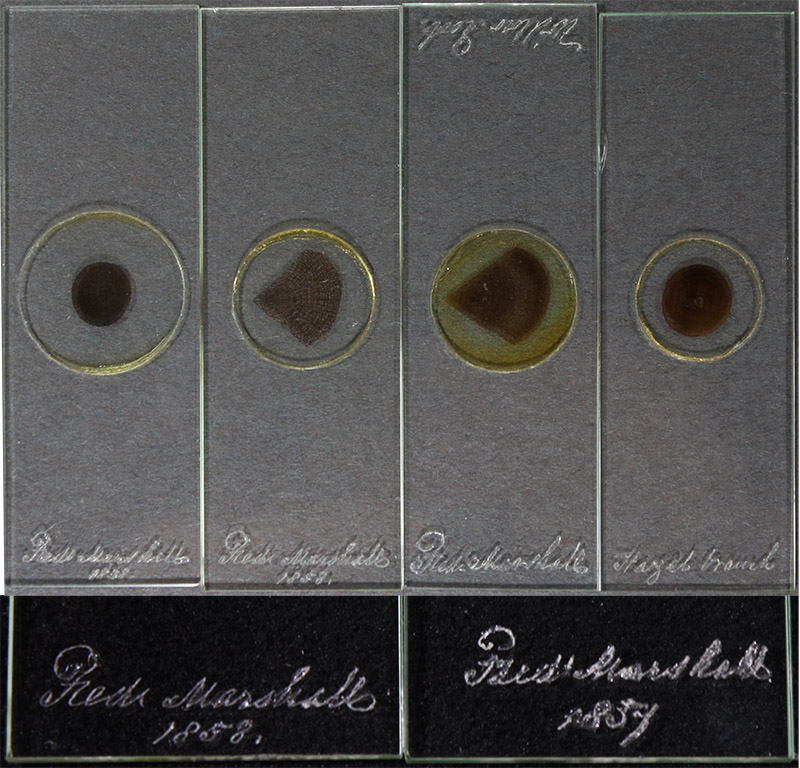
Figure 1.
Microscope slides with engraved writing, by Frederick Marshall. The three on the left are engraved with his name. The specimen descriptions on the right three slides are engraved in the same handwriting. The left two slides are dated 1858 and 1857. All are thin-cut botanical sections. Photographed on a dark background to highlight the engravings.
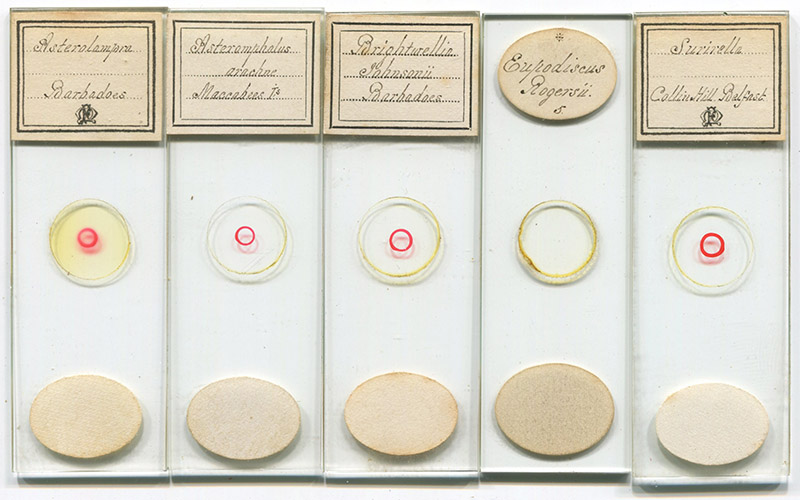
Figure 2.
Examples of diatom slides with Marshall’s labels and handwriting. The slides on either end have labels that bear monograms “F M”.
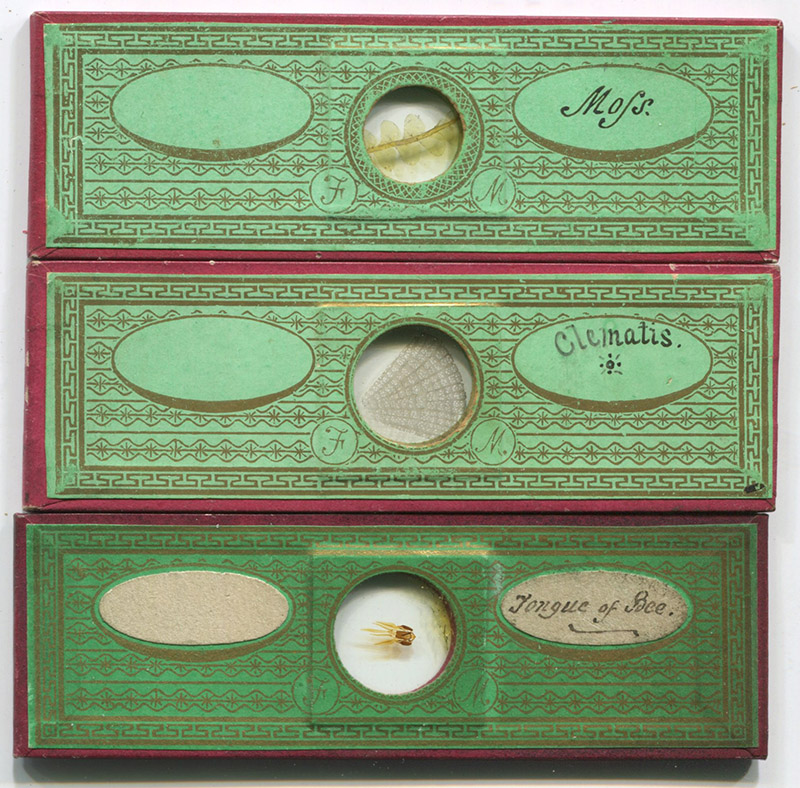
Figure 3.
Slides with custom-made cover papers that bear the initials “F” and “M” within circles, and Marshall’s handwriting. The initials were engraved into the printing plate.
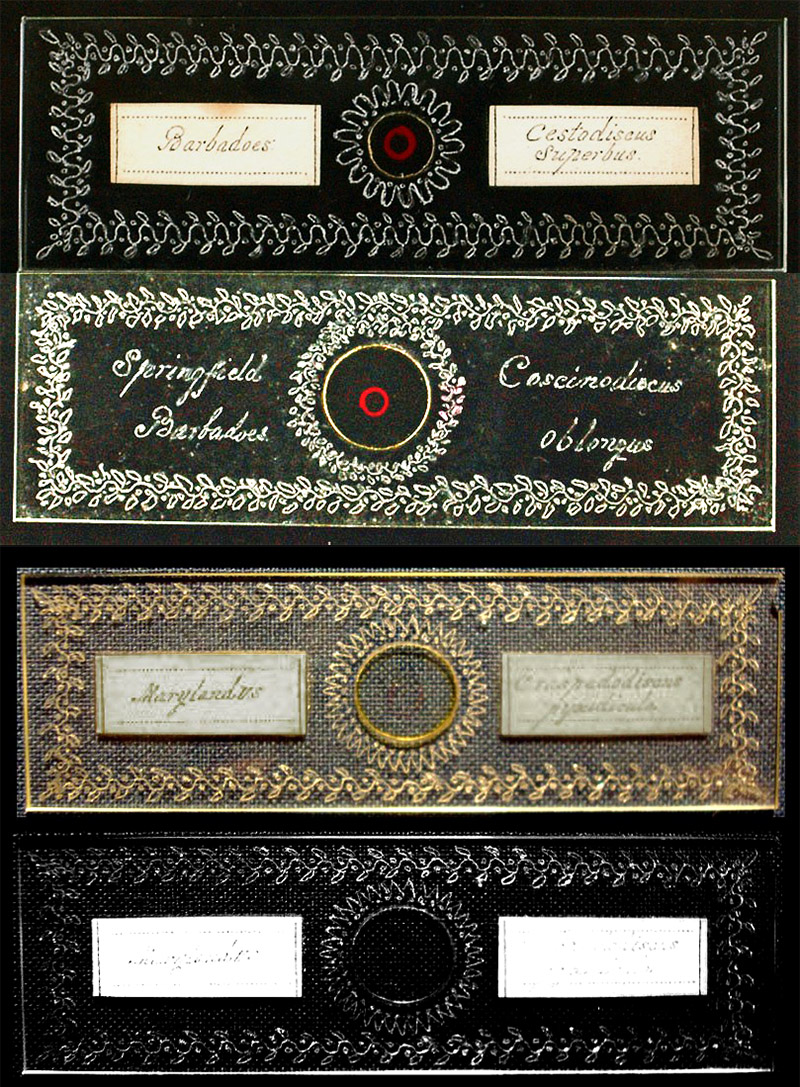
Figure 4.
Examples of microscope slides with delicate engravings of leaves, flowers, etc. cut into the glass slide, with Marshall’s handwriting either on paper labels or carved into the glass. These slides confirm that Frederick Marshall was a highly-skilled engraver. We know of the existance of two further examples of finely-engraved Marshall slides, in addition to the illustrated three. That number indicates that Marshall frequently put this high degree of effort into decorating slides, further supporting his identification as a person who was very comfortable with detailed engraving. Images adapted from various sources for nonprofit, educational purposes.
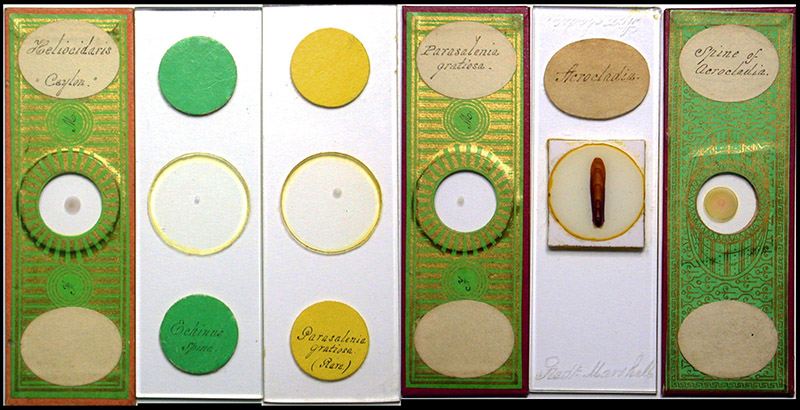
Figure 5.
Some Marshall preparations of echinus (sea urchin) spines. Several of these specimens were also donated by Marshall to the Quekett Microscopical Club in 1871.
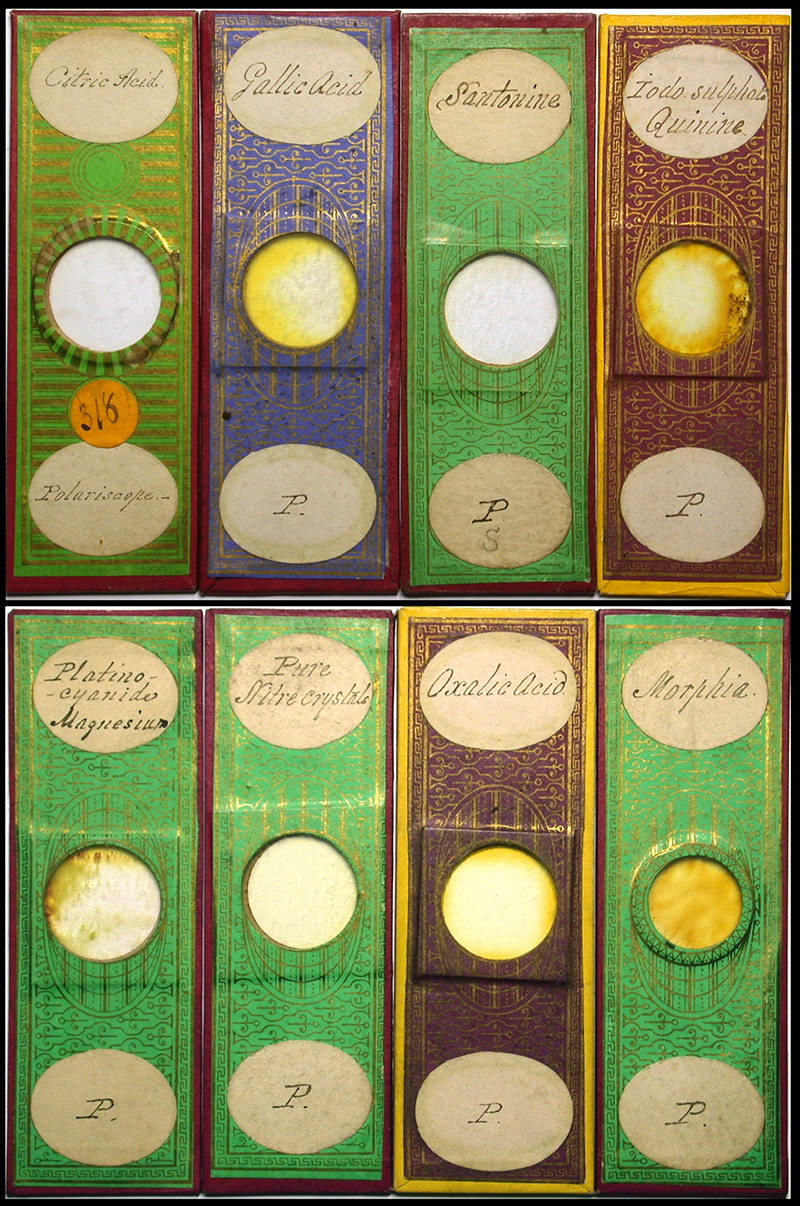
Figure 6.
Preparations of chemical crystals, for examination with crossed polarizing filters (polariscope).
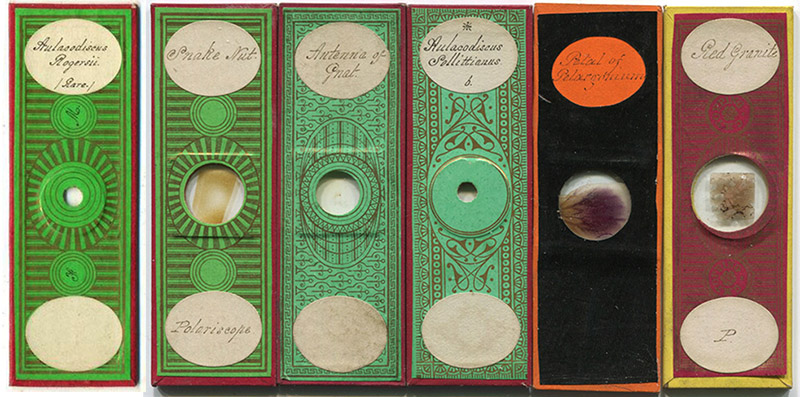
Figure 7.
Examples of paper-covered slides with Frederick Marshall’s labels. The slide on the far right was made by Charles M. Topping, upon which Marshall added his own handwritten label. The two slides on the left have cover papers with printed circles that are either empty or contain Marshall’s initials. Professional slide-maker Edmund Wheeler routinely used a customized version of that same cover paper, suggesting a connection between the two men.
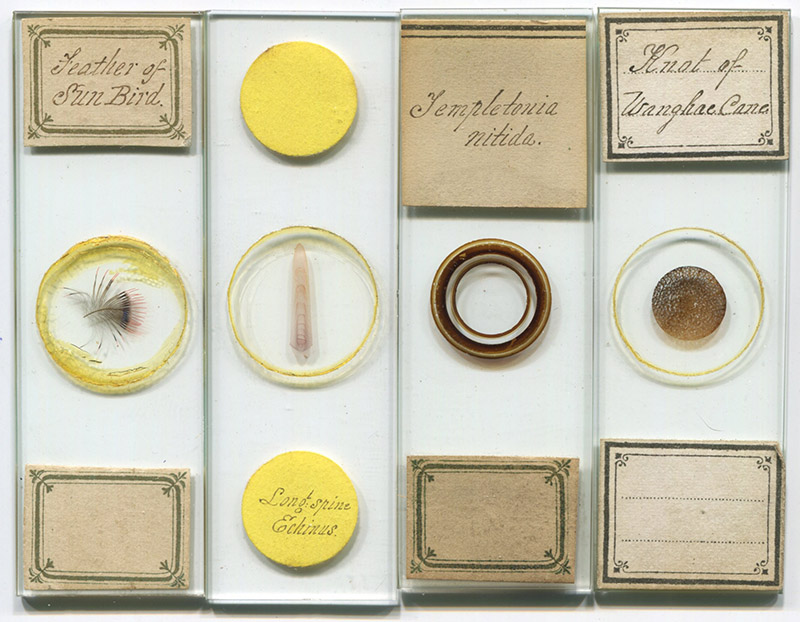
Figure 8.
Further slides with Marshall’s handwriting on the labels.
We have not yet firmly identified microscopist Frederick Marshall. From current data, the most likely candidate is a man who was a professional engraver and business owner:
Frederick Marshall, engraver and minister, 1820 - 1902
This person was born on February 18, 1820, the son of Thomas and Jane Marshall. He was christened on February 2, 1834 at St Matthew Bethnal Green, as were also two of his siblings (who were born in 1821 and 1823). The father’s occupation at that time was listed on the parish records as “tinplate maker”, and the family lived on Baker’s Row.
The first national census of England was conducted in 1841. Frederick Marshall was then living with a watch maker in Clerkenwell. The head of the household, Benjamin Warner, was listed as being a “secret springer”, and his twenty year-old son as a “watch maker”. Twenty year-old Frederick was listed as being an “engraver”. Two other young men, aged 20 and 15, were apprentice engravers.
Frederick married one of Benjamin Warner’s daughters, Emily Jane, later in 1841.
The 1851 census listed Frederick, Emily, and three daughters as living at Woodland Place, St. Pancras, Middlesex. He was an “engraver” employing “a man and a boy”.
The 1852 Post Office London Directory included, “Marshall Fred. engra. & enameller, 46 Rupert st., Haymarket”.
The 1861 census shows Marshall to have a thriving business, and enjoying a relatively comfortable life. Living at 23 Camden Cottages, Kentish Town, St. Pancras with his wife and six children, he employed “4 men and 2 boys” in his engraving shop. The family also had the services of a live-in general servant.
The situation was similar at the time of the 1871 census: they had a domestic servant in the house, and “master engraver” Marshall employed “2 men and 1 boy”.
Thus, Frederick Marshall the engraver was an upper middle class business owner, and was of a social level to readily associate with W.B. Carpenter and the Quekett Microscopical Club. His skills as an engraver are consistent with the finely-engraved slides shown in Figure 4. We know of four such surviving slides. Moreover, owning an engraving business would provide opportunities to prepare his own printing dies, for producing custom slide papers (e.g. Figures 2 and 3).
In addition to that evidence, Marshall the engraver left the London area circa 1873
Marshall was deeply involved in his church. During the early 1870s, he changed careers, and became a Baptist Minister. Reverend Marshall worked a wide circuit. For instance, during the months of February to June of 1884, he served congregations at Gower Street (London), Abingdon, Alvescot, Bampton, Grove, Maidenhead, and Windsor.
The 1881 census found Frederick at Chapel House, Clifton, Bedfordshire. His wife had died during the intervening years. An unmarried daughter, Mary Catherine (age 29), lived with him. He published at least two books of religious poems, Meditations from the Heart in 1884, and Transition, Ministering Spirits, and Other Poems in 1899.
Reverend Marshall died on February 18, 1902, in Bampton, Oxfordshire
An auction that was held in January, 1902, sold a collection of lepidoptera from a Reverend F. Marshall (Figure 9). This may have been our engraver/Baptist Minister.
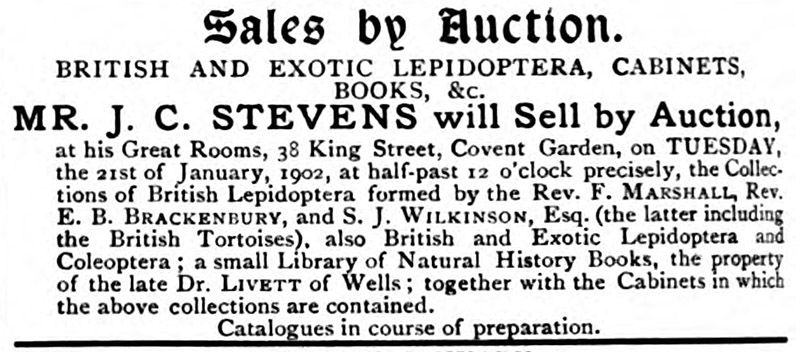
Figure 9.
A January, 1902 advertisement for the sale of lepidoptera that had been collected by Reverend F. Marshall.
Other candidates
Several other people have been investigated, many of whom can be eliminated as being impossible.
Three American Microscope Builders notes that a “Mr. Marshall” of London investigated the diatom Navicula spencerii using an objective lens that was made by Charles Spencer. However, John Quekett’s Treatise informs us that this Mr. Marshall’s first name was Matthew.
A Frederick Marshall, of Doncaster, advertised an exchange for entomology specimens in 1873. He was also described in a publication about insects, written by colleague John Polls. But, this person was too young to be the microscopist, as censuses indicate that he was born ca. 1845. Recall that our microscopist was preparing high-quality slides in 1857.
Another Frederick Marshall published several exchange requests in Hardwicke’s Science-Gossip during 1885. However, he was born ca. 1860, and so cannot be our microscopist.
We have investigated the lives of several other people named Frederick Marshall. Other than their being of an appropriate age and living near London, none present any recognizable connection with the microscopist. We welcome suggestions and conversations that can confirm the identity of the talented Mr. Marshall.
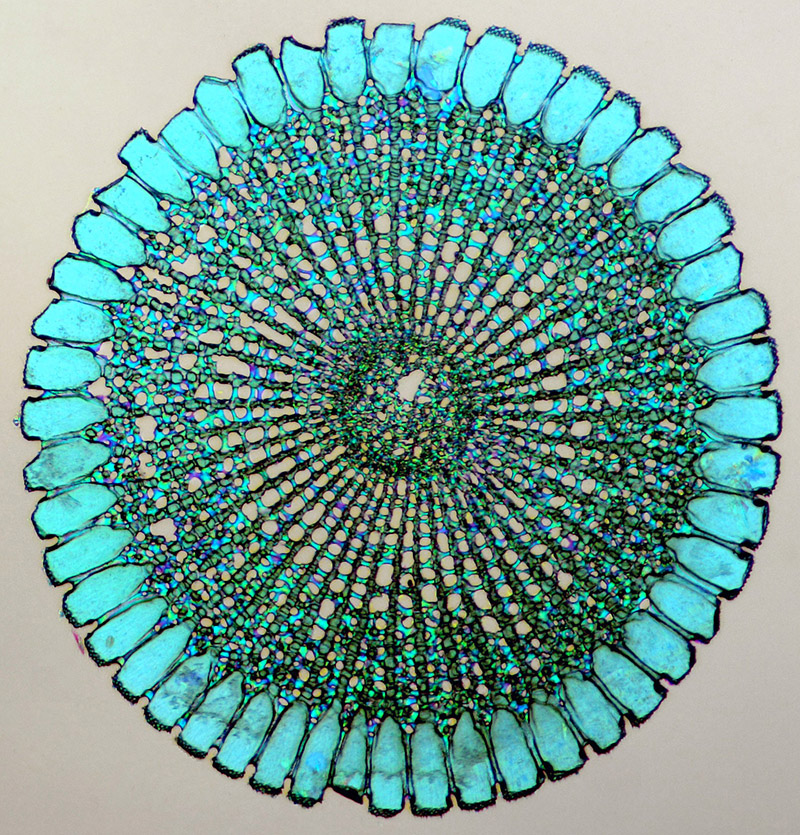
Figure 10.
Cross section of a Parasalenia gratiosa echinus spine, prepared by Frederick Marshall (3rd slide from left in Figure 5). Photographed using a C-mounted Sony Nex-7 camera on a Leitz Orthoplan microscope, 4x Plan objective with transmitted light, partially crossed polarizing filters, and blue selenite.
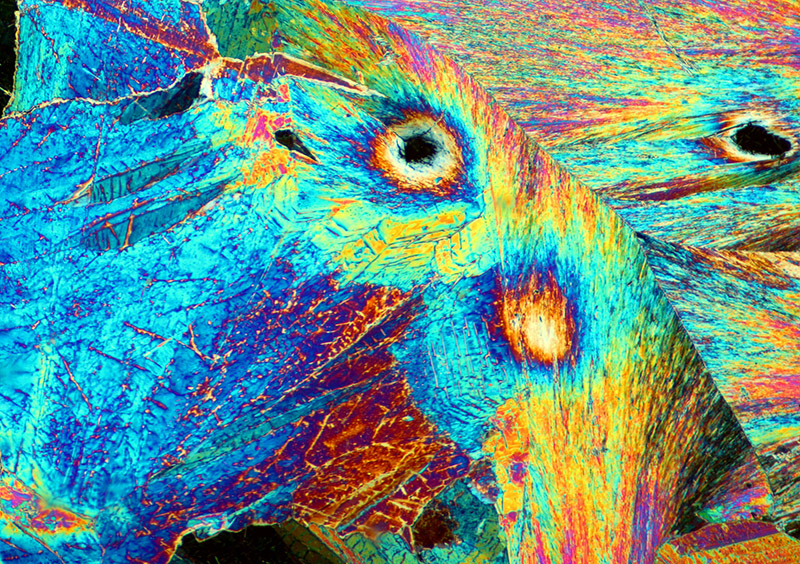
Figure 11.
Polariscope view of a Frederick Marshall preparation of citric acid (see Figure 6). Photographed using a C-mounted Sony Nex-7 camera on a Leitz Orthoplan microscope, 10x Plan objective with transmitted light and fully crossed polarizing filters.
Resources
American Optical Company (1944) Three American Microscope Builders, American Optical Co., Buffalo, NY, page 27
Bracegirdle, Brian (1998) Microscopical Mounts and Mounters, Quekett Microscopical Club, London, pages 43, 184, and 186, and Plates 40-Q and 41-J
Carpenter, William B. (1862) The Microscope and its Revelations, Third edition, John Churchill, London, page 227
Christening record of Frederick Marshall (1834) Parish records of St. Matthew Bethnal Green, accessed through ancestry.com
The Christian’s Monthly News, and British Protestant (1866) Vol. 1, page 5
England census, birth, marriage, death and other records, accessed through ancestry.com
Entomologist (1873) Exchange offer from F. Marshall of Doncaster, Vol. 8, page 416
The Goldsmiths', Jewellers', Silversmiths', Watchmakers', Opticians', and Cutler’s Directory (1863) “Marshall, F. (enameller), 46, Rupert-street, Haymarket, EC”, page 42
The Gospel Standard, or Feeble Christian's Support (1884) Vol. 50, February issue, page iii
Hardwicke’s Science-Gossip (1885) Exchange offers from F. Marshall of Cambridge, Vol. 21, pages 95 and 167
Journal of the Quekett Microscopical Club (1871) Vol. 2, page 242
Journal of the Quekett Microscopical Club (1872) Vol. 3, page 14
Marriage record of Frederick Marshall and Emily Jane Warner (1841) Parish records of St. James Clerkenwell, accessed through ancestry.com
Nature (1902) Advertisement for an auction that included “the Collections of British Lepidoptera formed by the Rev. F. Marshall”, Vol. 65, page cxiv
Polls, John (1873) Do insects recognize individuals?, Entomologist, Vol. 8, page 415
Post Office London Directory (1852) “Marshall Fred. engra. & enameller, 46 Rupert st., Haymarket”, page 871
Probate record of Frederick Marshall (1902) accessed through ancestry.com
Quekett, John (1848) Practical Treatise on Use of the Microscope, H. Balliere, page 440










